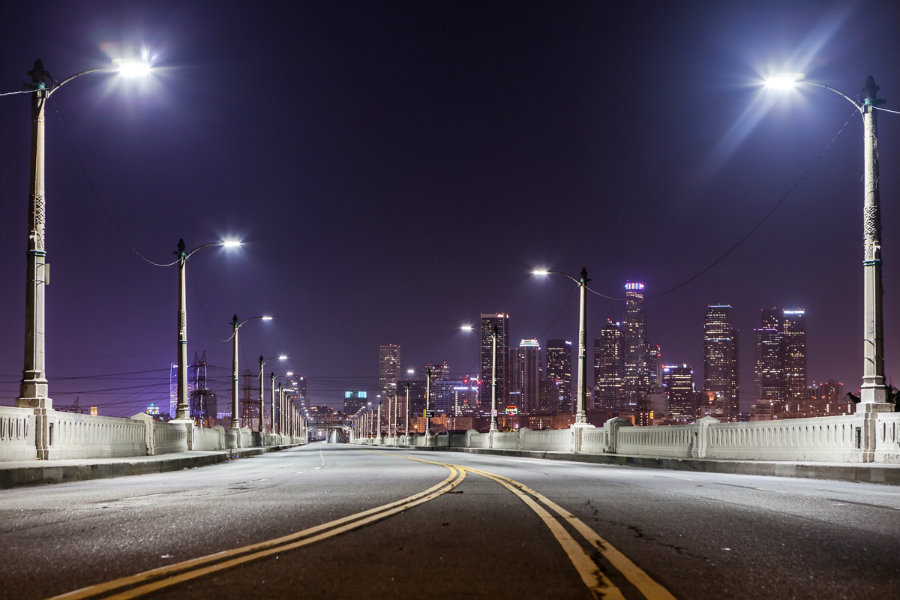LED lights, very commonly used in the major cities, might be disrupting sleep patterns, impairing drivers at night and even increasing the risk of heart disease and cancer, according to the American Medical Association.
LED lightings have seen widespread use across the United States of America. So far, nearly thirteen percent of streetlights and another roadway lighting is now LED. These type of lights save up to fifty percent more energy, spread light in an evenly way, and last twenty years, compared to the traditional high-pressure sodium lights that are yellowish and have a duration of around five years.

The problem with the first generation of LED street lights is that they have color temperatures of at least 4000 Kelvin, which means they produce bright white light that emits large quantities of unseen but potentially harmful blue light.
Its negative side effects include disrupting sleep rhythms, increase the risk of serious conditions such as cancer, cardiovascular diseases, obesity, diabetes, and impair driving vision at night.
In favor of LED streetlights
For many cities, these concerns do not outweigh the benefits from the first generation LED street lights they have already installed in the last few years. For example, a spokesman for Seattle City Lights, Scott Thomsen, noted that these bright white LED lights are less harmful than televisions and computers, which emits larger quantities of damaging blue lighting.
“Nobody says don’t watch television or use your computer after 9 p.m. because of blue lights,” has agreed Mark Hartman, Phoenix’s chief sustainability officer.
The Lighting Research Center at the Rensselaer Polytechnic Institute in Troy, New York, also disagrees with AMA. They note that the report is based on long-term exposure to high-intensity LEDs and that the hazard presented by the blue lighting likely will not be a concern for most people.
Thomsen has also stated that the initial complaints against the lights were probably caused by the very noticeable difference in brightness between sodium and LED lights, which worried some. He also argues that nighttime vision gets better, not worse since they let people distinguish colors at night — which makes for more accurate witness reports in crime cases.
Against the new light fixtures
Besides the health concerns, residents in some areas have complained that the bright white light is overly unflattering, harsh, invasive and cold. People belonging to the “dark sky” movement say that LEDs further contributed to what is known as “light pollution” in the night sky.
The American Medical Association’s report does not focus only on the hazards to people, they also noted, with some concern, the possible effects on the local nocturnal wildlife.

The director of the California Lighting Technology Center at the University of California, Michael Siminovitch, feels that federal authorities rushed in endorsing first generation LED lights. The Department of Energy and the Environmental Protection Agency gave the LED bulbs a large push, which might have been a mistake.
And before AMA report, some researchers were already raising concerns about the hazards of these bright white lights, as they might affect the circadian rhythm of the body.
The bright light could diminish the secretion of melatonin, a hormone that balances the thyroid adrenal and reproductive hormones in the body and regulates sleep patterns.
Possible compromises
While for some replacing the current first generation lights is not an option, there are still ways to heed the warnings presented by AMA.
For example, the city of Gloucester, Massachusetts decided to finish the installation of their new LED lights — but using lower intensity 3000K lights instead of the 4000K ones, after the city planner Matt Coogan decided to err on the side of caution after learning about the possible health hazards.
New York has responded to citizen’s complaints by replacing some of their harsh LED lights with newer, warmer and less intense ones. And Phoenix might instead implement a mix of both, with the warmer lights installed in residential areas and the more intense lights being used in areas that need such harsh lightings, such as ballparks and major intersections.
Lake Worth in Florida has decided to replace their sodium streetlights with LED lights that are amber instead of bright white. “We found a color that made sense for the health of our city, and we’re proud of the choice we’ve made,” stated the city manager, Michael Bornstein.
LEDs and Nobel Prizes
In 2014, the Nobel Prize in physics was awarded to Isamu Akasaki (from the Japanese Meijo University), Hiroshi Amano (Japan’s Nagoya University) and Shuji Nakamura (UC Santa Barbara) for their efforts in creating a blue light-emitting diode (a blue LED) used in smartphones’ screens.
The white LED lights are created by mixing red, blue, and green light, and until the nineties, blue light could not be made. LEDs are unique because they do not rely on filaments like sodium bulbs but in electrons. This gives LEDs the capacity to transform electricity directly into the light, without heating the device.
Source: The Washington Post
